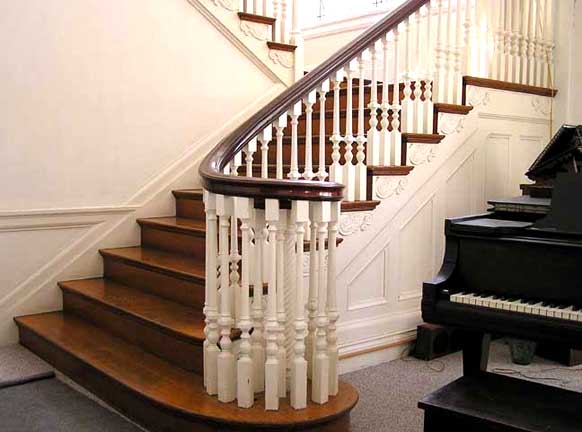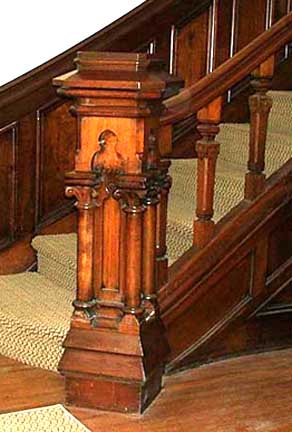Staircase (original) (raw)
Colonial (Pre-Revolutionary War) Colonial

Colonial period: The earliest true Colonial staircases from the pre-Revolutionary period are almost exclusively functional. Often steep stairs that run to an attic, they are typically paneled or boxed-in with no balustrade and possibly a few small turnings at the top. The Colonial stairways most admired today are from the Georgian and Federal period (about 1725 to 1820) and based on classical proportions and motifs.
- Illustration:Carpenters' Hall, Philadelphia, Pa. (1770-73)
- Drayton Hall, near Charleston, S.C. (1738)
- George Wythe House, Williamsburg, Va. (c. 1750)
- Wren Building, College of William and Mary, Williamsburg, Va.
- Governor's Palace, Williamsburg, Virginia (c. 1714)
- Bruton Parish Church, Williamsburg, Virginia (1715)
- Capitol, Williamsburg, Va. (1705)
Victorian (1870-1910)
including Queen Anne, Eastlake,Stick,Richardonian Romanesque, Folk Victorian

Increasingly sophisticated power woodworking machinery made possible more elaborate carving and turnings, it also made them less expensive and more widely available. Like mantels,Victorian staircases became a place to show off manufacturing ability and money.
With the adoption of combination living spaces and stair halls late in the period, stairs became the focus of further experiments, and more elaborate series of flights and landings were contrived.
Windows; Often the principal landing between the entrance floor and the floor above featured a stained-glass window. The richest windows were pictorial, while the more modest ones were geometric. Stair halls were regularly lit by skylights, either with plain glazing or stair glass, sometimes with elaborate designs.
Coverings:Carpet was the preferred stair covering, but floor cloths and matting were also used. Brass was a popular material for the stair rods, but iron and even, occasionally, silver are also found.
Newels: Victorian staircases start proudly with an elaborate newel, which is invariably highly detailed. Covered with embellishments- sometimes from a mixed bag of stylistic idioms - the most ornate examples are wonderfully rich with worked turnings and chamfers or applied carvings and rosettes. Newels with deeply turned balls or beaded decoration may show a geometrical influence associated with Eastlake furniture styling.
Somtimes gas, and later electric, newel lamps were instlled atop the post.
In simpler dwellings the newel could be the most elaborate piece of woodwork in the house.
Balusters: Victorian baluster designs span a wide range of turnings, square and tapered supports, and combinations of both. Sometimes the balustrade is not composed of true balusters but is instead an assemblage of horizontal and vertical members that forms a decorative grille.
Railings: Handrails are also more elaborate, with decorative beads and coves along the sides below the basic face molds. Oak is highly popular, as it is for all woodwork, but yellow pine is also sold.
Text primary source: Brent Hull, Stair Millwork by the Book (Old House Journal)
- Illustration:Second Empire - Robert B. Adam House (1876)
- Richardsonian Romanesque - Connecticut Street Armory (1900)
- Richardsonian Romanesque - Delaware Avenue Baptist Church (1895)
- Fred Eberhardt House (1889)
- Carlton Ladd House (1887)
- Williams-Pratt House (1896)
- Queen Anne - H. H. Little House (1891)
- Maytham House (1892)
- Henry Mooney House (1891)
- Queen Anne - Roos House (1887)
- Edward and Harriet Roth House, 102 Oakland Place
- Eastlake - 51 Symphony Circle
- James S. Fowler House
- Dr. and Mrs. Hubbard A. Foster House
- George L. Williams House
Colonial Revival (1880 to Present)
Georgian Revival, Queen Anne, Shingle
Newels: Compared to Victorian staircases, Colonial Revival newels are relatively simple, often resembling a large baluster. Square newels were also widely sold, especially during the 19th and early 20th century, but here the Colonial influence is readily identified by Georgian / Adam ornaments, such as urn-like turnings on the tops or carved swags and cameos applied to the sides. Often painted white.
Balusters: Colonial-influenced balusters are typically turned on a lathe and very thin. (Remember, turning was a favorite woodworking technique for furniture makers of the 18th century.) They use classical shapes for the patterns, and on very high-style homes, there may be more than one style of baluster in a balustrade.
By the 1890s, mass production made possible a fashion for the complex turnings of twisted balusters that appeared in many architect-designed houses. Open-string stairs, where the balustrade could be featured to best advantage, often varied baluster patterns and spacing.
Often painted white.
Text primary source: Brent Hull, Stair Millwork by the Book (Old House Journal)
- Illustration:Philip Smith House / College Club House (1904)
- George K. Birge House (1897)
- Conners House / Gilda's Clubhouse (1908)
- George L. Lewis House / Hope Lodge of the American Cancer Society (1891)
- Hotchkiss-Sidway House (1898)
- Plymouth Methodist Church / Karpeles Manuscript Library Museum(1912)
- Klinck House (1903)
- Mary Vought Lansing House (1898)
- John Durrant Larkin Jr. House (1915)
- Stella Lowry House (1894)
- Margaret Lautz Munschauer House (1894)
- Saturn Club (1922)
- Trible House (1905)
Arts & Crafts Inspired (1900-1940)
Bungalow,Foursquare,Tudor Revival

Unlike the heyday of the Victorian era in the 1890s, when embellished wood decorated almost every surface of a house, by the turn of the 20th century the Arts & Crafts movement was introducing new design ideas and alternate materials, such as tile, metal, and exposed brick on fireplaces. Innovative staircases in landmark Arts & Crafts buildings like Red House (designed for William Morris by his friend Phillip Webb) and the Gamble House (designed by the brothers Greene) left their mark on stair millwork for decades to come.
Newels: Like the furniture, most Arts & Crafts staircases are, at first glance, clean, unornamented, and deceptively simple. Ideally, there is no carving or other ornament, and what decoration does exist is meant to appear structural - for example, the workings of mortise-and-tenon joints or other connections. The square-topped newel ringed with a shallow molding like the brim of a hat is, fittingly, nearly ubiquitous in Foursquare houses.
Balusters: Balusters are square-edged and unadorned. Sometimes you see tapered sides, cutouts, or fretwork in wide,flat balusters. Treads might be dominated by a single board baluster as wide as 7", or pairs that alternate between 4"-wide boards and narrow 7/8"-square sticks.
Railings: Typically bearing little or no molding, handrails are very smooth and merely rounded at the upper corners,often looking proto-Modern in the most high-style examples.
Text primary source: Brent Hull, Stair Millwork by the Book (Old House Journal)
- Illustration:Bungalow - Roycroft Museum (1910)
- Arts & Crafts - Automobile Club of Buffalo (1911)
- Arts & Crafts - Roycroft Inn (1900)
- Arts & Crafts - Statler House (1910)
- Arts & Crafts -Roycroft Print Shop
- Arts & Crafts - Palmer House
- Tudor Revival (Jacobean Revival) - Buffalo Seminary (1909)
- Tudor Revival - Charles W. Miller House (1879)
- English manor - Schoellkopf-Vom Berge Manor (1912)
- Art Nouveau - Guaranty Building (1896)